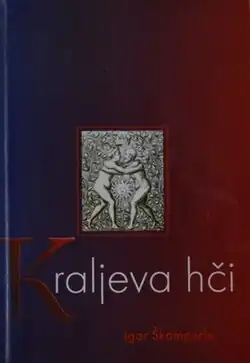Kraljeva hči
 | |
| Author | Igor Škamperle |
|---|---|
| Language | Slovenian |
| Published | January 1, 1997 |
| Publisher | Založba Devin |
Publication date | 1997 |
| Publication place | |
| Pages | 336 |
Kraljeva hči is a novel by Slovenian author Igor Škamperle. It was first published in 1997 by Založba Devin (Cankarjeva založba)[1]
Content
The story follows Ernest Fabian, a history professor from Trieste, who travels to Prague after receiving a mysterious invitation. On the train, he falls in love with his fellow passenger Katka Živan, who lives between Ljubljana and Prague, and they begin a romantic relationship. In Prague, master Karl Belehar recruits him into a Masonic lodge, where he is to represent Slavic and Slovenian interests in a project for a new European order. Just before a lodge session, Katka’s husband Mathias Breital, also a key member of the group, discovers their affair, prompting the lovers to retreat to a mountain solitude, though they cannot endure it. Ernest attends the session, while Katka returns to Ljubljana. With the help of the mysterious antiquarian Karl Mardohaj Zalman, Ernest catches the Freemasons in a symbolic card game in a monastic library, where, under German influence, they decide the fate of the lands. He disrupts the game and leaves, choosing privacy and his love for Katka over the lodge.
Parallel to this, a historical narrative unfolds about Emperor Rudolf II’s alchemist Mihael Meier, with whom Ernest identifies so deeply that he feels his wounds. In 1592, Mihael Meier searches for mercury ore with Andrej Vok Rožmberk in the Czech mountains. He sleeps with a peasant widow, Jerina, experiences a peak during the Midsummer Night, but she is later burned as a witch, and he flees back to court. In 1599, Emperor Rudolf II grants religious freedom, only to revoke it in 1609; three years later, mentally ill, he dies. His successor, Matthias of Habsburg, loses interest in alchemy. The defeat of the Czechs at White Mountain on November 8, 1620, marks the start of the Thirty Years’ War.[2][3][4]
See also
References
- ^ Umek, Loredana (2007). "Poti tržaškega romana na prehodu stoletja (1997-2007)". In Košuta, Miran (ed.). Slovenski slavistični kongres, Trst 2007. Živeti mejo: Živeti mejo, Slovenska književnost v stiku, Slovenski jezik v stiku, Slavistika in slovaropisje v stiku, Zamejska mladinska književnost [Slovenian Slavic Congress, Trieste 2007. Living the Border: Living the Border, Slovenian Literature in Contact, Slovenian Language in Contact, Slavic Studies and Dictionary in Contact, Youth Literature in the Borders] (PDF). Zbornik Slavističnega društva Slovenije, 18 (in Slovenian). Ljubljana: Slavistično društvo Slovenije. ISBN 978-961-91015-9-9. ISSN 1408-3043.
- ^ Matajc, Vanesa (2023-09-27). "Bralec nad "hermetično posodo": Igor Škamperle: Kraljeva hči ("Hermetic Container": Igor Škamperle: The King's Daughter)". Clotho. 5 (1). Literatura (Ljubljana): str. 194–198. doi:10.4312/clotho.5.1.365-370. ISSN 2670-6229.
- ^ Čremošnik, Gregor (1915). Jurčičev “Ivan Erazem Tatenbah (in Slovenian). Ljubljanski zvon: Ljubljanski zvon. pp. str. 194–198.
- ^ Hladnik, Miran (2009). "SLOVENSKI ZGODOVINSKI ROMAN" (PDF). University of Ljubljana, Faculty of Arts, 2009. 1st edition (1st edition. - Ljubljana : Scientific Publishing House Faculty of Philosophy, 2009). Ljubljana: 318. ISBN 978-961-237-291-0 – via slov.si.